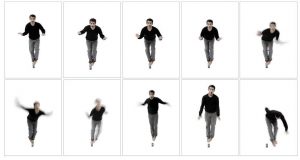

I will jump off a Pepsi can. I may call it an attempt to measure the distance between me & my biography; the mere desire to watch a short silent film. That is a very long distance for someone like me besieged by slowness & remembrance! The distance just before the fall will suffice; to examine my obsessions’ and fate in this world at this very moment.


In the video work Jumping Off a Pepsi Can, the artist frames himself as the subject,p erforming a solitary act – that of jumping off a soda can. But what can the viewerm ake of this somewhat comedic modern day Charlie Chaplin-esque performance?W hat does this at first laughable act have to do with life, and the inspiration Al-O thman finds in a quote he attributes to Duchamp: “My art is that of living”. After all, jumping off a small drink container is not an everyday part of life, liket he quotidian moments of brushing teeth or bouncing a ball. It’s an absurd act- the artist seemingly daring himself to jump off a platform a mere 11cm off the ground. The work was inspired by a story Al-Othman once heard about, in whicha performance artist jumps off a building as his work of art. The building is a few stories above the ground. He breaks his bones, but survives. In Jumping Off A Pepsi Can, Al-Othman takes a quite serious approach to his own jump. As we watch the video, we are struck by the intensity of his concentration and the attempt by the artist to go deep within himself, at first to balance on the small surface area of the can top, and then to find the “inner nerve” to finally jump. With his inspiration for the piece pulled from the story of the performance artist who jumped off. A nd again, and again, reflecting one of the particular and mesmerizing aspects of v ideo art, or moving picture art: the looping of the video. As the video loops, and t he longer we watch, it takes us deeper and deeper into the artist’s eye and mind. U ltimately, Jumping Off A Pepsi Can overcomes its darker dimension and lands usp ositively on our own two feet. As we watch the artist recover his life, we feel t he exhilaration of the next jump. And the next. [Curator’s note; For additional explorationo n the art of jumping, see Philippe Halsman’s Jump Book, 1959. Photographer Halsman developed “ap hilosophy of jump photography, which he called ‘jumpology.’”]b uilding, it is clear the Pepsi can stands in for a building. Once we see this, we watcht he piece as if Al-Othman is also jumping from a building. Of course he survives,b ut the act is empathic, seeking to feel – even for an infinitesimal moment – thet error of the suicidal act of throwing oneself to a likely death from the top of ab ridge, a building, a cliff. Or in this case, from the miniature precipice of a soda can.W hat is especially captivating is that if we keep watching the video as it loops, wec an enter into the piece as witnesses to the complete circle of a life: life, death,a nd, yes, rebirth, as the artist jumps, lands, and survives to keep jumping again.
Curator Mary Teeling review,